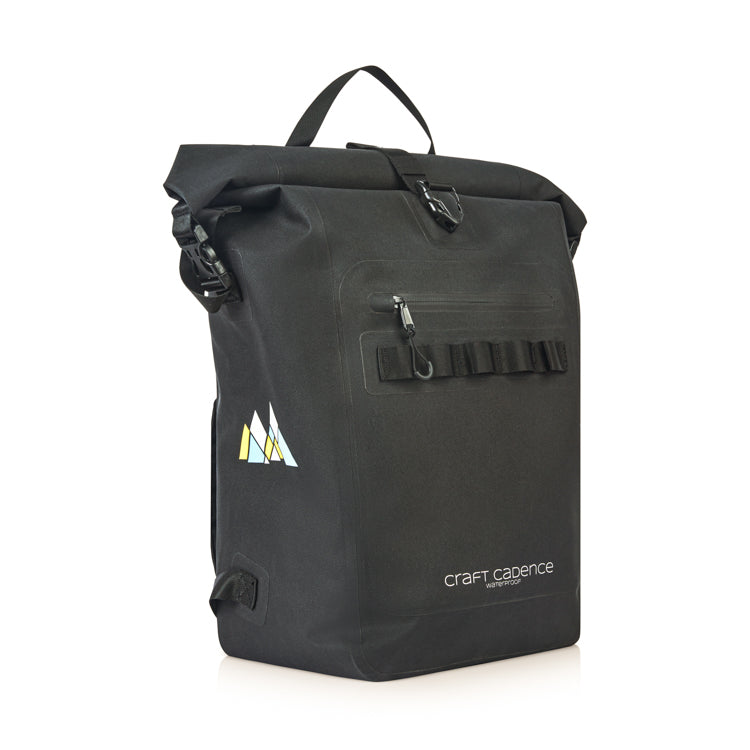Nanofibre versus Melt Blown mask filters - Why N95/N99 filters are not all created equal
Craft Cadence is a UK based cycling bags and pollution masks brand that helps commuters stay organised and breath clean air. This is part of series of blog posts covering topics surrounding pollution and the role of masks for effective filtration.
Why do we need filters for face masks?
If you are reading this article, you are already a nuanced consumer when it comes to masks and protection. You are probably aware that filters for removable masks are there to filter our tiny particular matter (PM). This could come from pollution (e.g. NOx), smog, industrial processes, viruses, dust, and smoke from forest fires.
You are probably also aware of PM2.5, which refers to the size of particulate matter, specifically at 2.5 microns (0.025 mm in diameter). To understand the size of microns, we have written a separate article here. To summarise, the diagram below shows the scale of different particles at different sizes.
Before the pandemic, it was mostly adequate for mask filters to filter out particulates at 2.5 microns, which cover most dust, pollen, allergenes, industrial gases and pollutant particles.
However, with the prevalence of viral particles which come at much smaller sizes, attention has focused on the ability of filters to filter out much tinier particulates at 0.3, 0.1 microns, and even particles less than 0.1 microns in diameter.
Coronavirus particles, of which SARS-CoV-2 is part of, is approximately 0.1 microns but can be as small as 0.06 microns, according to research from the New England Journal of Medicine. The relative size of coronavirus particles in relation to other particulates can be see below.
At the start of the pandemic, the governments of most countries issued guidance not to wear “medical” grade masks such as surgical masks or respirators with N95 or N99 ratings (if you are unfamiliar with these ratings, see our article here). This was primarily done to ensure sufficient supply for frontline medical staff. This meant most consumers used fabric based face coverings without filters.
After a year of further scientific research and media attention, the broader public now knows that the use of filters and/or non woven materials improve filtration and the efficacy of face masks and that purely fabric masks fare comparatively poorly.
This is why some countries, such as Canada, have moved to recommend the use of high density polypropylene filters as middle layers for use with reusable face masks. Germany and Austria have made medical-grade masks compulsory on public transport and in shops.
Reusable face masks with filters versus medical grade masks
Does that mean medical grade mask or respirators are now the answer? Not necessarily. As we have shown in previous articles, the filtration efficiency of surgical masks lag behind those of well fitted PM2.5 pollution masks, owing to the large gaps that allow air to pass through the sides, top and bottoms of surgical masks.
N99 respirators perform best both in real and lab conditions (when properly fitted) and are used by frontline staff treating COVID patients, but they are not comfortable or practical for use for prolonged periods in daily life. They are also comparatively expensive on a per hour usage basis and are single use only, and therefore worse for the environment.
Consumers will also continue to prefer washable face masks over medical masks for other reasons. They can display more personality through designs, are more fashionable and less impactful to the environment. The key difference maker now for reusable masks squarely lie on the filters that come with them.
Let’s therefore dive into filters in more detail and find out how filters are made and what features you should look for.
What are N95 and N99 certifications for mask filters?
Prudent consumers should firstly look for a N95 or better still, a N99 rating on their mask filters. This refers to the ability of the filter to filter out 95% (N95) or 99% (N99) of particulate matter at 0.3 microns. A N95 or N99 certified filter is an indication that the filter has passed third party laboratory test that proves the filtration efficacy of the filter in question, based on an international standard recognised by the WHO.
The thing to be aware of is that the commonly referred to N95/N99 rating is based on the performance standard NIOSH 42 CFR 84 from the National Institute for Occupational Safety and Health (NIOSH) in the United States. There are equivalent ratings from other parts of the world which are applicable under different regulatory regimes.
To know that you are getting a filter that is certified to a level equivalent to N95 and N99, refer to the following table. For example for N99, look for FFP3 in Europe, P3 in Australia P2, and 3rd class in Japan.
Look for filter makers that will publish, or provide to the consumer the exact results of their N95 or N99 certification. This demonstrates they are transparent and can back up the efficacy of their filters. Check if the certification body is a reputable company itself, such as Nelson Labs in the US, or a global verifier such as SGS, DNV or Bureau Veritas.
In addition, probe the company to see if they can also provide lab results of filtration efficacy at particulate matter lower than 0.3 microns. In many cases, filters can be just as effective at filtering out at 0.1 microns as 0.3 microns, but the lab results for 0.1 microns do not appear on the certificate because it is not required to pass the certification at that level.
A reputable supplier of filters should be able to disclose their test results at various particulate matter sizes.
So, you have now found suppliers of N95 or N99 filters. Is that the end of the story?
The answer is not so simple. To find out, let’s find out how N95/N99 filters are traditionally made, and learn about the new technologies disrupting the market - nanofibre filters.
What is melt blown technology for filters, and how is it made?
The market dominant technology for making N95 or N99 filters is the melt blown processing method. This involves spinning a synthetic polymer, most commonly polypropylene, into a dense nonwoven fabric. The melt-blown stage applies hot, high-velocity air which draws the polymer filaments into into very fine filaments (approx 1 micron diameter). This results in ultrafine fibers that yield both excellent filtration properties and good insulating properties.
It is relatively easy to produce in large quantities and has a good weight to surface area ratio. Typically, the meltblown layer is sandwiched between two thinner spunbound layers, which are produced in a similar way but without the thermal heating element. It can also be combined with an activated carbon fibre layer to form a 4, or 5 layer filter.
An illustrative diagram is provided below:
The downside of meltblown fabrics is that it is by its very nature not very breathable, which may pose an inhalation risk for certain individuals with breathing conditions.
Another major weakness of melt blown fabrics is that it is inherently designed not to be washed. A single 5 minute dip of a N95 melt-blown filter in a 75% ethanol solution showed that the filtration efficiency decreased from 95% to 80%. It is not recommended to ever wash a melt blown filter if it can be avoided.
This can be a problem with manufacturers of face masks where the melt-blown filter is sewn between the outer and inner layers of the mask and cannot be removed. If that is the case, gently wash the mask by hand and limit the exposure of water to the inner filter layer.
The fact that few manufacturers publish studies about the impact of washing on the filter’s filtration efficacy probably indicates that this is a major drawback of melt-blown filters.
However as we will see, new technologies are stepping up to the plate and early results from laboratory and real life testing show particular promise for nanofibre filters.
New kid on the block - nanotechnology for mask filters (nanofibre filters)
Nanotechnology for air filtration has been traditionally applied in air purifiers, and its application for mask filters is relatively new and recent. A nanofibre filter is defined as fibre less than 1 micron in diameter, though it is common for the fibres to be as little is 0.1 micron in diameter, or even less.
It can be made using the same material as melt-blown filters, i.e. polypropylene. However, new materials such as polyvinylidene difluoride (PVDF), is also being used. The most common technology for producing nanofibre filters is the electrospinning method.
In this method, the melt-blown process is replaced by a process where electric fields are applied to draw out, and produce continuous fibres that are extremely thin (0.001 to 0.5 microns in diametre). This results in fibres that are even more tightly bound than melt-blown fabrics, as can be seen in the diagram below.
Although a more expensive technology, a number of game changing advantages has put nanofibres into the spotlight. These include:
Filtration efficiency
Nanofibre can retain its filtration efficiency longer than melt-blown fabrics - nanofibre has smaller ‘pore’ diameter and closer interconnected membranes than melt-blown fabrics.
“It is significantly superior to that of commercial glass fibre and melt-blown polypropylene fibre-based filtration membranes” - Science magazine.
Breathing comfort
Nanofibre has been shown to offer superior breathing comfort. A breathability test was conducted by researchers in Japan and Korea comparing nanofibre and melt-blown fibres. It was found that the nanofibre has a higher moisture vapor transport rate (WVTR) than melt-blown fabrics (see diagram below). This essentially means that it is able to wick moisture out of the mask more effectively.
Reusability after sterilisation or washing
Nanofibre has been shown by multiple studies to be retain filtration efficiency much better than melt blown fabrics after either sterilisation or washing.
In the same study by Ullah et al, researchers applied an ethanol solution to sterilise masks with nanofibre and melt-blown filters. The nanofibre filter was able to retain much of its filtration efficiency at 98% even after 10 rounds of spraying cycles using an ethanol solution.
By contrast, the melt-blown fabric began at a higher filtration efficacy rate of 99%, but that dropped to 62% after 10 spraying cycles.
Worryingly for the melt-blown fabric, even after one sterilisation cycle, the filtration efficacy dropped from 99% to 65% after dipping in a 75% ethanol solution for 24 hours. At the same time, the nanofibre fabric retain its filtration efficiency.
While more studies need to be conducted to affirm these findings, there is growing evidence that nanofibres can maintain filtration efficiency for longer, can be reused and rewashed for longer periods, and is more comfortable to breathe through than melt-blown fabrics.
Knowledgeable and prudent consumer should therefore ask mask suppliers for information on their fabrics such as:
- The technology used to produce the filters
- What their washing/care instructions are
- Whether they have laboratory tests on the loss of filtration efficiency after usage and washing/sterilisation
- Whether or not the filter is combined with antiviral or antibacterial treatments. This would be a strong combination because the antiviral or anti-odour treatment(s) effectively makes the mask self cleaning, meaning that there is less need for it to be washed as often, further prolonging its usage life.
Craft Cadence face mask with nanofiber technology
Craft Cadence is pleased to announce that our new V2 ViralOff face masks will come with both a sewn in N99 certified nanofibre filter, and the option to insert removable N99 certified nanofibre filters to further prolong the life of the mask. This is the first mask in the world (that we are aware of) to have both options available.
Most mask provider will either have the filters sewn in but not the option to insert removable filters, or allow for removable filters without a sewn in filter.
The reason why we are providing both is that a sewn in filters provides the best filtration efficiency possible as the filter covers more surface area and because it is sewn in, there is no chance for the filter to move around.
We also added a filter pocket to use removable filters further down the line because we think it is wasteful to throw away a mask once the sewn in filter has reached the end of its useful life.
We think it is the right thing for the environment to continue using the mask with removable filters for as long as it is possible. We make less money this way but it is the right thing to do.
In summary, our V2 ViralOff reusable mask will come with the following layers, soon to be released in April/May 2021:
- Layer 1: ViralOff antiviral technology on outer layer made from recycled polyester
- Layer 2: Nanofiber FFP3 (N99 equivalent) certified filter sewn in between 2 fabric layers
- Layer 3: Stays Fresh anti-odour and antibacterial inner layer from recycled polyester
- Layer 4: An additional Stays Fresh recycled polyester layer to create a filter pocket
We are also pleased to be able to provide on request:
- The FFP3 (N99) certified report of our nanofiber filters
- An internal wash report which shows that the filter loses 2% of the filtration efficiency after 10 washes. We will look to gain third party certification of the after wash filtration efficiency of the filter in the future.
- Our Polygiene ViralOff laboratory results and certification, showing that our outer layer eliminates 99% of viruses within 2 hours, including SARS-Cov-2.
Conclusion
Although reusable masks with filters has traditionally been used for anti pollution, dust and smog purposes, the global pandemic has shed further light on this industry.
In response technology has rapidly evolved and nanofiber filters carry distinction advantages over the incumbent melt blown technologies, which justifies it’s higher price tag
As consumers, we should not be using purely fabric based masks anymore, if we can afford to.
For mask filters, look for manufacturers that can provide information on the materials and technologies used to produce its filters, what level of certifications the filters have achieved, and furthermore, any laboratory tests on the filtration efficiency loss rates of usage and washing.



